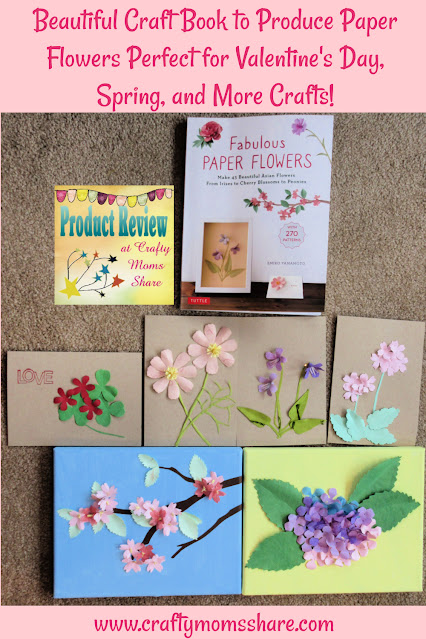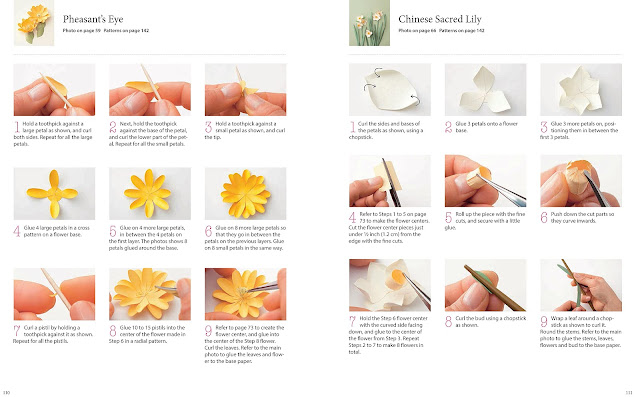Disclosure: I was sent a copy of this book in exchange for an honest review. All opinions are my own.
Last spring, I used a book by Emiko Yamamoto to create paper wildflowers which I used on spring cards. Today I get to share her next book that also gives tutorials and templates to make beautiful paper flowers. The book is Fabulous Paper Flowers by Emiko Yamamoto.
From the Publisher:
Exquisite paper flowers that never wilt!In this book, Japanese paper crafting expert Emiko Yamamoto reveals her secrets for making realistic blossoms, leaves and stems from inexpensive colored paper sheets. Her simple cut-curl-paste method is perfect for beginners—making it easy to create dozens of lifelike flowers.
Fabulous Paper Flowers features 43 varieties of Asian flowers for every season, including:
- Spring: Wild Cherry Blossoms, White Clover, Japanese Primrose, Japanese Marigolds & Fuji Dawn Violets
- Summer: Bigleaf Hydrangea, Japanese Iris, Water Lilies, Mountain Peony, Japanese Morning Glory & Evening Primrose
- Fall: Cosmos, Japanese Bush Clover, Cranesbill Geraniums, Japanese Maple Leaves & Gingko Leaves
- Winter: Heavenly Bamboo, Japanese Camellia, Snow Camellia, Pheasant's Eye, Japanese Plum & Chinese Sacred Lilies

The finished pieces look great as table settings, wearable brooches, gift toppers, in framed displays, on handmade cards and so much more. Make wedding decor on a budget, decorate for a baby shower, make a dinner party special or surprise a loved one with a handmade gift—with this book, the possibilities are endless!
This complete how-to guide has descriptions of the easy-to-find materials and tools, templates that you can trace and cut out, and step-by-step photos showing you how to curl and crease the pieces, then assemble them with dabs of glue.
From Me:
Since my Mother's Day and spring cards were so well-loved last year, I decided to create some Valentines for my family this year using some of these beautiful flowers. I looked at the flowers and picked some that were in the pink and purple colors. Although many of the flowers in this book are naturally pink or purple, so I had many from which to choose. I fell in love with the Fuji Dawn Violet that is on the cover, so that is one I had to try. I found the templates and instructions very easy to follow. There is also an entire section of large photos of the paper flowers to help with the placement of the parts of the flowers.
I pulled out some 5" by 7" cards (or A7) in a paper bag color to make my Valentines. I also went to my supply of handmade and special papers to create these flowers. The instructions were easy to follow and the templates are very easy to use!
My next card features the Japanese Primrose. I loved the pink flowers. The hardest part of making these flowers is cutting the details of the petals and leaves. For supplies you need the paper, sharp scissors, glue, a toothpick, a chopstick, a knitting needle, and I used a safety pin but the book called for an awl. I love how Emiko shares some everyday items to use in place of fancy tools.
I decided to try the Cosmos next. I feel like my flowers are a bit big for the leaves, etc. They also filled the card quite a bit, but they are pretty! I think it would have looked better on a bigger sheet of paper. My final card is with the Oxalis. I changed the color of the flower. The picture in the book shows yellow and pink flowers. I however did not have a great shade of pink for it and didn't like the pinks I had on the brown bag background. I changed it to red. One of the things I love in this book is how there is a little bit about each flower in the photograph section. I learned that the oxalis closes both the flowers and leaves in the evening.
For my cards I used some Valentine themed stamps. You can see the Love on the card above. Each of the cards have "Happy Valentine's Day!" inside as well. I wanted to try some of the bigger flowers as well. I decided to try some home decor with them. The Bigleaf Hydrangea is shared in the book. It is apparently the type of hydrangea most common in Japan. Even though it is called Bigleaf, I found the leaf template to be too small and made my own leaves much bigger. Hydrangeas have a special place in my heart. They were the flowers we used at my wedding and also my father began propagating hydrangeas after he retired. He gave us several that are in our yard, and they always remind me of him. He no longer can garden with his Alzheimer's, so I am happy to have them. I always love the old hydrangeas that have the different colored flowers on one plant so I went with that when I planned this flower.
I had painted a small canvas yellow for the background of my hydrangea. I also painted a small canvas light blue to use with the cherry blossom. My cherry blossom is still a work in progress. I stopped making the flowers so I could share the book with you sooner!
I still need to make some more flowers for the empty branches! This cherry blossom art is better than the one I made years ago for my review of The Last Cherry Blossom (a Multicultural Children's Book Day review). This wall art is perfect for decorating for the Cherry Blossom Festival in case you cannot get to Japan (or anywhere they grow cherries). The book has flowers found in Japan throughout the year. I love how it is divided by season. Many of the flowers are similar to ones found in the United States including some favorites like peonies, poppies and more! I hope you will check this book out and get crafting!










